Tom, Dick, Harry and George, The Great Canadian POW Escape From Luft Stalag III, Near Sagan, Poland 1944.
Yes, there was a movie made in Hollywood, which was released in 1963 called The Great Escape. It starred Steve McQueen, Charles Bronson and James Garner. The movie was based off the book, that had the same name, and was written by Paul Brickhill in 1950.
There was also a popular American television sitcom series called Hogan's Heroes which ran from 1965 to 1971 and starred, actor Bob Crane. 168 episodes were produced in that series.
The "real" Great Escape, which these Hollywood productions are loosely modeled after, didn't include any American POWs at all, according to Mr. Albert Wallace, who was held there for 18 months. Mr. Wallace is now 96 years old and resides in Toronto, Ontario Canada.
As the story goes, all the prisoners of war, that were held at Luft Stalag III were British, Australian, New Zealand and Canadian Airmen along with British Naval Officers. These men represented the British Commonwealth countries, and were the original POWs of the camp. American Army Air Force Officers didn't start arriving until late in the year of 1943. Then, another camp was built to house them in early 1944.
The Airmen considered it their unwritten duty to try to escape. They organized and used all their skills to construct 4 elaborate escape tunnels under the huts that they were being housed in. All skills were used.
The notable Canadians were:
"Big X" also known as James Buckley. He came up with the original strategy to dig 4 independent tunnels.
Gordon Kidder was fluent in German and French and could also speak a bit of Spanish. He taught other prisoners enough conversational German to improve their chances of escape if they got questioned while on the run.
Hank Birkland had a strong mining background before the war broke out. He knew how to dig and reinforce tunnels. He became the expert tunneler.
Patrick Langford was known for his fast agility and brute strength. He was the"guardian" of Harry's entrance. It has been reported that he could warn the tunnelers and move the iron stove back over the tunnel's opening in 20 seconds.
George McGill was a third generation coal merchant and was studying engineering before the war. He won awards for being able to run the fastest quarter mile. His intelligence was quickly recognized and he was responsible for security and the implementation of an early warning system for the prisoners.
Keith Ogilvie was the parcel officer who was put in charge of the distribution of the Red Cross ration packages. He became the "bribe" guy and would trade items for items that were needed for the escape.
Albert Wallace was known as a "penguin", who's job it was to relocate the soil that was being excavated out of the ground. The soil from the tunnels was a different colour than the soil found on the ground and it had to be put somewhere. The legs were cut out of long underwear and used to hold the sandy soil inside the pants the prisoners were wearing. Once outside, the prisoners would walk to a garden they kept, one person would turn up the soil, the "penguin would waddle over the hole and move in a side to side motion to release the soil. Then it would be buried.
Each tunnel had a name and they were respectively called: Tom, Dick, Harry and George.
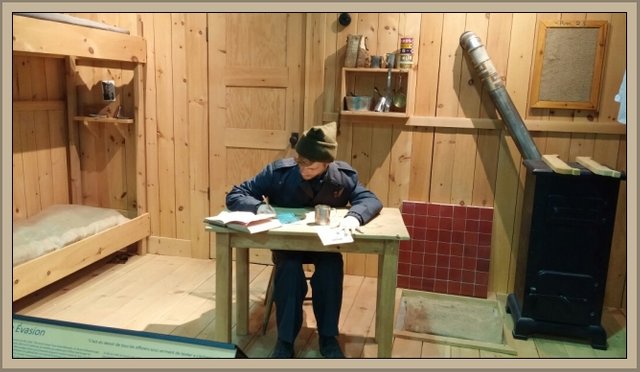
This is an exhibit found inside the National Air Force Museum of Canada, located in the Trenton ward of the City of Quinte West, Ontario Canada.
Canadian Air Force Base, Trenton is home to 8 Wing, 424 Squadron and the museum just to name a few things that make CFB Trenton, unique.
The exhibit is showcasing what one of the huts looked like that the Airmen were being held in, as prisoners.
It shows the entrance to Harry which was located under a stove in room #23 of hut #104.
(As mentioned before, It was Patrick Langford's job to guard Harry's entrance and move the iron stove as needed. He could perform this task in 20 seconds.)
The tunnel named Tom, had its entrance hidden inside a chimney's foundation.
Dick's entrance was hidden under a shower drain and George's entrance was hidden under the stage in the theatre.
Harry was the longest of the 4 tunnels. It burrowed 9 meters or almost 30 feet down into the earth.
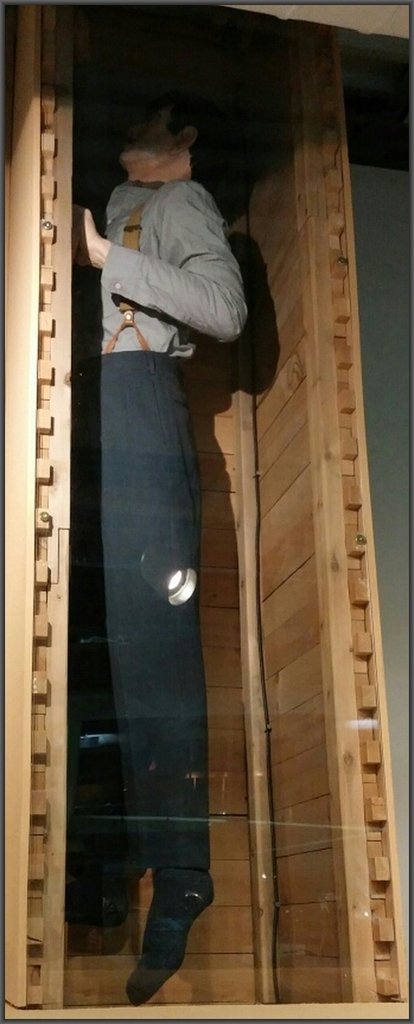
Harry was also over a 100 meters or over 300 feet long. The prisoners were tunneling through soil that had a high concentration of sand. In order to shore up the sides and the walls of the tunnels, the prisoners used boards from their beds. Every scrape of all matter of materials was used and re-purposed to fill a need that the prisoners had in concocting their escape plan.
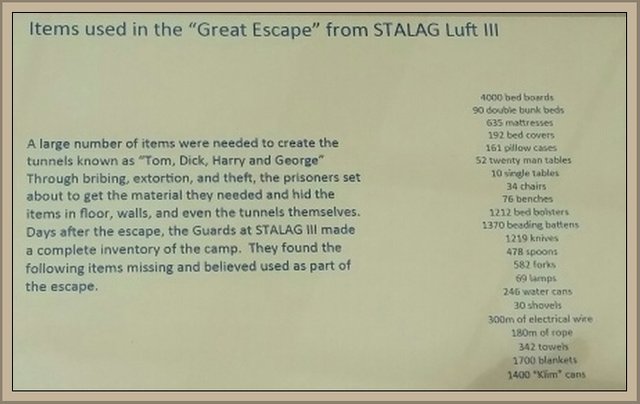
Here's a list of items that were inventoried by the Germans and believed to have been used to orchestrate the Great Escape. I took the picture of the list from the museum's exhibit. Notice that the count on the bed boards alone, totals 4000.
It's a wonder they could even sleep on their bunk beds. It certainly makes you ponder how all these items could mysteriously go "missing" without any of the guards noticing and it makes me question if there was a "blind eye" being turned, perhaps in sympathy for the prisoners' plight.
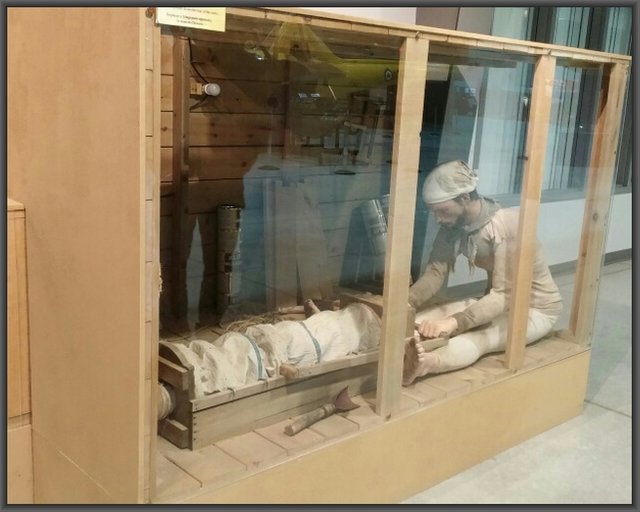
This museum exhibit shows the bellows that had been fabricated from "the Red Cross supplied" war rations that the prisoners' received that were doled out by Keith Ogilvie. The bellows were crafted from Klim powder milk cans, fabric pinched from kit bags and the whole mechanism was cobbled together with hockey sticks. (Don't forget, there was a high amount of Canadian ingenuity being applied here and I don't know a single Canadian, to this day, who hasn't used a re-purposed hockey-stick for a different application in addition to playing hockey. They make great tools.)
The bellows supplied oxygen for the tunnels.
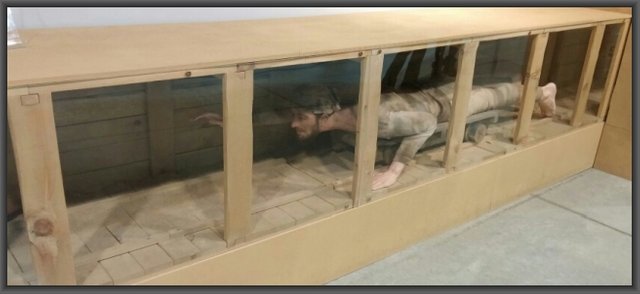
It was a long roll on your belly, pulling yourself along with the power of your arms and hands to the end of Harry.
When the tunnelers realized that they had managed to tunnel under the fencing of the camp, they quickly realized that they were also 3 meters or almost 10 feet shy of the protective cover of the forest's edge. This would prove to be the demise of their entire escape plan.
Originally, it was decided that 200 prisoners would try to escape. A lottery was drawn among all the prisoners to select who would try.
On the day of the planned escape there were problems. Part of the tunnel collapsed, there was an air raid, a door was frozen shut and the forged documents that were dated for sometime in March 1944, were about to expire. The escape committee decided to let 100 of the 200 prisoners try to escape. By 5 am during the planned night of the escape, only 75 men had made it into the tunnel. Three of the 75, had successfully made it to the safety of the Allied lines, the rest were re-captured within a few days and sadly 50 were executed. Their hands were bound behind their backs and they were shot in the head. Their murders were ordered by Hermann Goering whom Adolph Hitler had put in charge of running Luft Stalag III.
Six Canadians were among the prisoners murdered, including the language specialist, named Gordon Kidder.
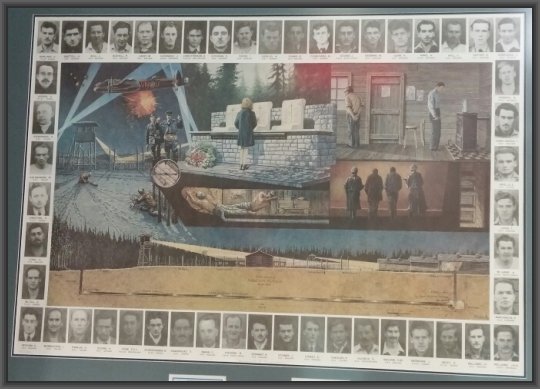
This is a picture of the 75 men that tried to escape on that faithful day in March, 1944.
It hangs on display as part of The Great Escape exhibit at the museum.
Please note that I am not a history buff, an Air Force or World War II expert. All of the information that I have provided came directly from what I learned at the National Air Force Museum of Canada. I have put this information into my own words, in an effort to share this story and preserve this particular version of history.
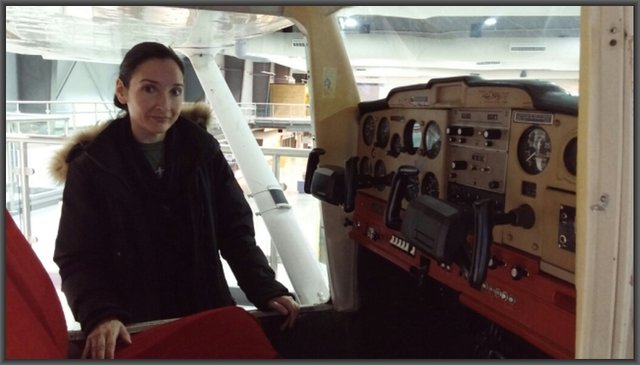
Here I am looking through the cabin of a little Cessna at the National Air Force Museum of Canada.
I welcome your comments and invite you to follow me on my journey.
~ Rebecca Ryan
Good job @rebeccaryan !It's a very interesting post :)
Thank you @djsonic! It is a fascinating story.
http://www.dailymail.co.uk/news/article-2183626/Escape-Colditz--glider-sheets-porridge.html
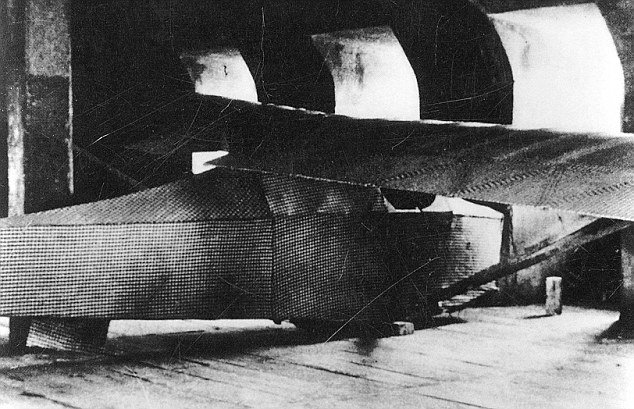
That is a fantastic article @mainenigma! Thanks for posting the link. I greatly enjoyed it.
It really speaks to the tenacity of the POWs.
Very nice post. I can tell I need a trip up to your neck of the woods one day soon.
If you want to read a fascinating book, it's called something like "Escape from Colditz". It is a fascinating account of these fellows and others, and their incredible ingenuity. Even if war stories are not your thing, the stuff they came up with was absolutely amazing from the human ingenuity perspective. I think the article @mainenigma describes about the plane is in a second book. Hard to fathom. Thanks for the posts on history.
It's absolutely wild what they used to make the glider with.
Lots of porridge as glue and starch to make the sheets used on the wings of the glider stiff.
I always ask myself, "what would I do, if it were me in that situation?"
That's why continuing to learn is so important...so that you can strengthen your skills and lean on them if you ever need to.
Happy New Year to you and yours!
Hard to keep the rats and mice away from eating your plane while waiting to escape too. Didn't know about the porridge and starch. Classic.
I guess the adage about porridge sticking to your ribs is true, especially the sticky part.:)
"Sticks to your ribs, and GREAT for plastering together a flying machine". Maybe we can go in together, sell that to Vern's Porridge Co. , get rich and split the proceeds. Then again, maybe we should stick to Steemit posting...
LOL! Steemit and porridge. Things that stick with you.
there was a team of enthusiasts in England a few years ago that built a replica of the glider, using the tools and equipment the men had available to them in Colditz. (with a couple of exceptions for safety).
They then test flew it...... and it worked! They confirmed that if it had been launched then it wold have flown as intended.
As you said, remarkable men.
Yes! @mainenigma posted the link to the story about the POWs housed in the Colditz castle.
You can view the newspaper article link at the top of this thread.
It's an absolutely fantastic story of tenacity and determination to be free from captivity.
It's hard to believe what can be cobbled together with boards, sheets and porridge.
Thanks for sharing @trevor.george! I really appreciate it. :)
Hi @rebeccaryan, I just stopped back to let you know your post was one of my favourite reads yesterday and I included it in my Steemit Ramble. You can read what I wrote about your post here.